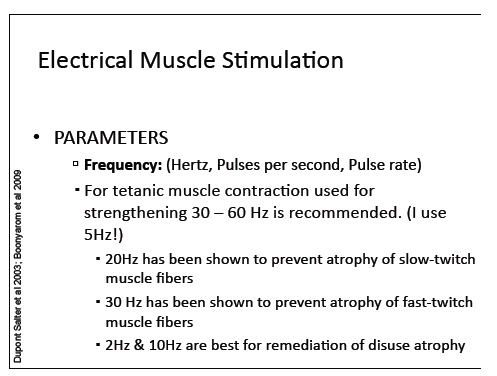Laurie's Blogs.
Aug 2015
NMES / E-stim Settings
Hello!
I have been starting to play around with NMES on patients and the settings I was given seem to be very different than what you are doing. So far both of my patients that I have tried this on (one neuro case - brachial plexus avulsion and one post op cruciate patient) seemed to be very uncomfortable. The settings I was taught at 5-10 Hz for pain (TENS) 20-35 Hz for strengthing and PW of 100 - 250 for pain (TENS) and 250 - 400 for strengthening.
When reviewing your website it seems you stick to 5 Hz and a pulse width of 100 most of the time. Do you seem to have good success using these standard settings or do you make a lot of adjustments based on individual patients?
Thanks so much
L.
---------
Hi L,
The setting you were given are 'traditional' use... but are not current in regards to the research.
I stumbled upon using 5pps by accident and was pleased with how well it worked and was then later delighted that the research showed it was preferential anyways!

The bonus with using 2 - 10 Hz (anywhere in there), is that you get pain relief, muscle activation & strengthening (especially if you have the dog work with it - i.e. 3-leg stands), and it is very effective for reduction of swelling.
Excellent results - enough so that I never (ever, ever) use 30 - 60Hz anymore.
The pulse width give you 'better bang for your buck'. So you get a stronger contraction at 300usec than 100... but it's also less comfortable.
The a Brachial Plexus injury that I am using the NMES to TEST for muscle fx, I will use my 5pps with a higher pulse width... giving the best possible chance that the muscle can contract.
Otherwise if your animal is painful with NMES, try lowering your pulse width and/or trying the lower frequency.
AND make sure you are using enough gel... really make your spot (under each electrode) well 'gooped' right down to the skin.
I hope this helps!
Best of luck!
Laurie


